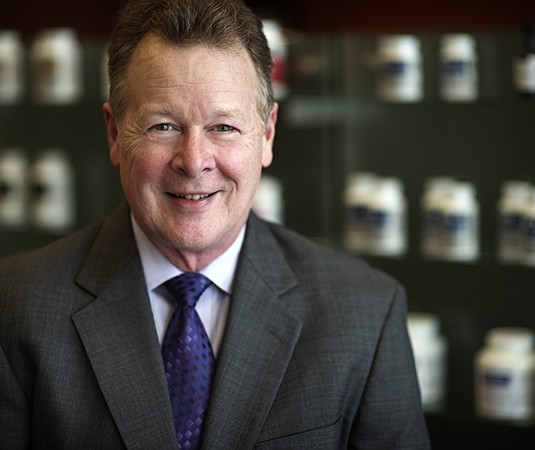By Jim Paoletti, BS Pharmacy, FAARFM, FIACP
Once a woman enters perimenopause and begins to experience symptoms such as hot flashes, It it often assumed that she needs estrogen.
The truth is: A woman’s estrogen levels do not decline until the last 6 to 12 months of perimenopause. Furthermore, estradiol levels typically rise slightly when a woman first enters perimenopause, so the hot flashes experienced at this stage of life are not actually caused by a lack of estrogen.
Many health practitioners were taught to measure FSH levels to confirm that estrogen levels were low. However, it has been shown that estrogen is not the major controller of FSH. Instead, FSH is controlled primarily by inhibin, a hormone produced in the corpus luteum.
Once ovulation ceases, the corpus luteum will no longer produce inhibin, so FSH rises due to lack of inhibit and not lack of estrogen. Progesterone is also produced by the corpus luteum, so elevated FSH is reflective of decreased production of progesterone. A physiologic amount of progesterone is required to make estrogen work correctly.
In early peri-menopause, a woman’s hot flashes are most often caused by a lack of progesterone rather than lack of estrogen.
Although progesterone is key for obtaining optimal effects of estrogen, other hormones may cause or influence the symptoms that we often perceive as a lack of estrogen.
- High cortisol levels can also cause weight gain, irritability, irregular cycles and hot flashes, even in the present of normal estrogen levels. Consistent low cortisol can also cause or aggravate hot flashes.
- Low thyroid function can cause similar symptoms that appear as estrogen deficiency.
- Insulin resistance can do the same.
In recent years, one of the biggest changes to approaching physiologic hormone balance is the way estrogen need is approached. Because so many other hormone levels affect estrogen and estrogen receptors, correcting other hormone issues have led to further and further reduction in the amount of estrogen commonly administered. In other words, if the other hormone or endocrine issues are addressed first, then the amount of estrogen required to treat her assumed “estrogen deficiency” symptoms becomes much less.
No symptom or set of symptoms guarantees estrogen needs.
Many symptoms can be explained by another possible hormone imbalance. Even vaginal dryness or atrophy, which almost always indicates a lack of estrogen, can exist when estrogen levels are normal. Vaginal tissues are also supported by testosterone and thyroid, and a significant deficiency in one or both of these hormones can be the source of the problem. Lack of progesterone can also result in ineffective estrogen. Properly assessing estrogen need and assessing response to estrogen therapy requires balancing the other endocrine hormones simultaneously or prior to estrogen administration.
At certain stages, even precise estrogen level measurement may not reliably indicate need. Estradiol levels begin to fluctuate during peri-menopause, with much wider vacillations towards the end of perimenopause. Therefore, it is wise to not rely on estradiol level measurements during this period. The best approach would be to correct deficiencies or issues with progesterone, cortisol, thyroid, insulin resistance and nutrition or lifestyle, then correlate remaining symptoms with levels, and address estrogen therapy as required.
Does she really need that much estrogen?
Even when women do need estrogen replacement therapy, they are often given too much. Excessive estrogen may help control the hot flashes for a month or two, but eventually the symptoms return.
Too much estrogen causes the same symptoms as too little estrogen, just with a slight time delay before the symptoms return.
At first, excessive estrogen increases the number of estrogen receptors, but after a period of time the body downregulates the number of receptors, so the estrogen cannot work properly regardless of how much is there.
Premarin® 0.625 mg or Estrace® 0.5 mg dosages were commonly administered for years, yet these dosages result in an excessive estrogen burden for all women. The majority of estradiol given by mouth is converted and significantly increases risk of breast cancer. Estradiol levels resulting from these medications may be at normal premenopausal levels, but estrone levels will be significantly higher than normal. Premarin® contains 50% estrone and 5-19% estradiol (along with a bunch of horse estrogens!). For the most part, the estradiol in it is quickly converted to estrone, so what the patient is really receiving is a strong dose of estrone. While Premarin® produces normal premenopausal levels of estradiol, estrone levels are usually 7-10 times higher than they should be. Clinicians typically measure only the estradiol level when managing BHR therapy.
Estrace® is bioidentical estradiol, but again the usual doses given by mouth produce too high an estrone level, usually 3-5 times higher than normal.
Topical administration of estrogen is safer and enables administration in a manner where the correct ratio of estradiol to estrone can be accomplished. Topical administration is a very efficient manner to deliver hormones, so must lower doses are required as compared to the oral route.
Because many practitioners have erroneously assumed that venous blood measurement can be used to determine the amount of topical dosing, doses much higher than physiologic amounts are commonly used. Capillary blood or saliva testing should be used with topically applied hormone to obtain a true representation of the amount of hormone being delivered to the tissues where the hormones work.
Too often, excess hormone is used based on serum testing. Then, the symptoms return as a result, and even more hormone is given! Symptoms of too much of any hormone are very, very similar to symptoms of too little of that hormone!
If the hormone has worked for a period of time and is no longer effective, it is usually a good indication that too much hormone has been administered.
The keys to optimal physiologic estrogen replacement therapy are:
- Make sure she needs estrogen by correlating symptoms with measurement of levels.
- Never assume a woman needs estrogen.
- Always restore progesterone to a physiologic level before assessing how much—if any—estrogen is needed.
- Test cortisol with a 4 x per day saliva test to help determine adrenal influence on “estrogen deficiency” symptoms. Address as necessary.
- If symptoms of hypometabolism (hypothyroid) are present, test the TT4, fT4 direct, fT3 direct, TPO and TSH to properly assess. Address appropriately.
- Check insulin resistance if symptoms indicate and address appropriately
- ALWAYS start very low on estrogen dosing and make changes slowly.
- Take steps to ensure safe estrogen metabolism by optimizing liver conjugation, bowel elimination, methylation and glutathione conjugation and by reducing lipid peroxidase activity.
Jim Paoletti, BS Pharmacy, FAARFM, FIACP, is the Director of Education at Power2Practice and a Clinical Consultant with over 30 years’ experience creating and using bio-identical hormone therapies in both retail pharmacy and clinical practice.
Jim is a Diplomat in Functional Medicine in addition to being a former faculty member for the Fellowship of Functional Medicine.
At Power2Practice, Jim applies his wealth of knowledge and experience by hosting live webinars and creating useful content, such as blogs, podcasts and clinical support tools.


